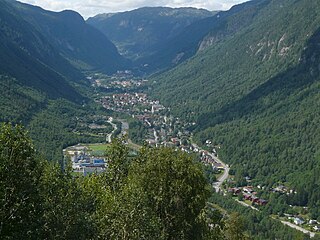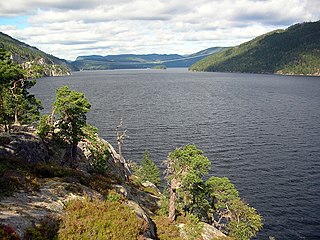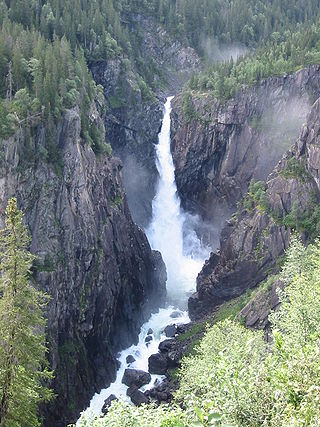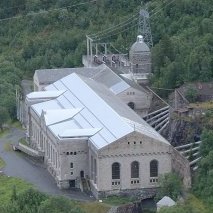
Tinn is a municipality in Telemark county, Norway. It is located in the traditional districts of Aust-Telemark and Upper Telemark. The administrative centre of the municipality is the town of Rjukan. Some of the villages in Tinn include Atrå, Austbygde, Hovin, and Miland.

Norsk Hydro ASA is a Norwegian aluminium and renewable energy company, headquartered in Oslo. It is one of the largest aluminium companies worldwide. It has operations in some 50 countries around the world and is active on all continents. The Norwegian state owns 34.3% of the company through the Ministry of Trade, Industry and Fisheries. A further 6.5% is owned by Folketrygdfond, which administers the Government Pension Fund of Norway. Norsk Hydro employs approximately 35,000 people. Eivind Kallevik has been the CEO since May, 2024, following Hilde Merete Aasheim.

Rjukan is a town in Tinn Municipality in Telemark county, Norway. The town is also the administrative centre of Tinn Municipality. The town is located in the Vestfjorddalen valley, between the lakes Møsvatn and Tinnsjå. The municipal council of Tinn declared town status for Rjukan in 1996. The town is located about 10 kilometres (6.2 mi) to the west of the village of Miland and about 20 kilometres (12 mi) to the northwest of the village of Tuddal.

The Norwegian heavy water sabotage was a series of Allied-led efforts to halt German heavy water (deuterium) production via hydroelectric plants in Nazi Germany-occupied Norway during World War II, involving both Norwegian commandos and Allied bombing raids. During the war, the Allies sought to inhibit the German development of nuclear weapons with the removal of heavy water and the destruction of heavy-water production plants. The Norwegian heavy water sabotage was aimed at the 60 MW Vemork power station at the Rjukan waterfall in Telemark.

Vemork is a hydroelectric power plant outside the town of Rjukan in Tinn Municipality in Telemark county, Norway. The plant was built by Norsk Hydro and opened in 1911, its main purpose being to fix nitrogen for the production of fertilizer. At opening, it was the world's largest power plant with a capacity of 108 megawatts (145,000 hp).

Johan Olaf Brochmann Nordhagen was a Norwegian educator, architect, engineer and artist. He is most commonly associated with his restoration designs for Nidaros Cathedral in Trondheim, Norway.

Tinnsjå is one of the largest lakes in Norway measuring about 51.38 km2 (19.84 sq mi). It is also one of the deepest lakes in Europe, reaching a depth of 460 m (1,510 ft). Tinnsjå is located in the municipalities of Tinn and Notodden in Telemark county. At its source in the west, the Måna river flows out of the lake Møsvatn and past the town of Rjukan into Tinnsjå. From the north, the river Mår flows from the lakes Mår, Gøystavatn, and Kalhovdfjorden into Tinnsjå. Tinnsjå is part of the Skien watershed, and it drains via the Tinnelva river in the south, down to the lake Heddalsvatn.

Rjukan Falls (English) or Rjukanfossen (Norwegian) is a waterfall in the western part of the Vestfjorddalen valley in Tinn Municipality in Telemark county, Norway. The 104-metre (341 ft) tall waterfall is located on the river Måna, about 5 kilometres (3.1 mi) to the west of the town of Rjukan.

Møsvatn or Møsvann is a lake in Vinje Municipality in Telemark county, Norway. It is the tenth-largest lake in Norway with a surface area of 79.1 square kilometres (30.5 sq mi) and a volume of 1,573,523,000 cubic metres (1,275,676 acre⋅ft). The lake lies just east of the Hardangervidda National Park, in Skien watershed (Skiensvassdrag) catchment area. The lake discharges into the Måna river at a dam located on the Vinje-Tinn municipal border. The lake has an irregular shape with three arms. The longest length across the lake is about 40 kilometres (25 mi). Møsvatn is a shallow mountain lake by Norwegian standards, reaching a maximum depth of 68.5 metres (225 ft).

Joachim Holmboe Rønneberg was a Norwegian Army officer and broadcaster. He was known for his resistance work during World War II, most notably commanding Operation Gunnerside, and his post-war war information work.

The Rjukan Line, at first called the Vestfjorddal Line, was a 16-kilometre (10 mi) Norwegian railway line running through Vestfjorddalen between Mæl and Rjukan in Telemark county. The railway's main purpose was to transport chemicals from Norsk Hydro's plant at Rjukan to the port at Skien, in addition to passenger transport. At Mæl the wagons were shipped 30 kilometres (19 mi) on the Tinnsjø railway ferry to Tinnoset where they connected to the Tinnoset Line. The Rjukan Line and the ferries were operated by Norsk Transport, a subsidiary of Norsk Hydro.

The Tinnoset Line was a 30-kilometer (19 mi) long Norwegian railway line that went from Tinnoset to Notodden in Telemark county. The railway was part of the transport chain used to transport fertilizer from Norsk Hydro's factory in Rjukan to the port in Skien. The railway opened in 1909 and was closed when the plant closed in 1991. The railway is sometimes mistakenly believed to be part of the Rjukan Line.

Tinnsjø railway ferry was a Norwegian railway ferry service on Lake Tinn that connected the Rjukan Line and Tinnoset Line. The 30-kilometer (19 mi) long ferry trip made it possible for Norsk Hydro to transport its fertilizer from the plant at Rjukan to the port in Skien. The ferry services were operated by the company's subsidiary Norsk Transport from 1909 to 1991, when the plant closed.

SF Hydro was a Norwegian steam powered railway ferry that operated in the first half of the 20th century on Lake Tinn in Telemark. It connected with the Rjukan Line and Tinnoset Line, at Mæl and Tinnoset, operating between 1914 and 1944. The combined track and ferry service was primarily used to transport raw materials and fertilizer from Norsk Hydro's factory at Rjukan to the port in Skien. It was the target of a Norwegian operation on 20 February 1944, when resistance fighters sank the ferry in the deepest part of Lake Tinn to prevent Nazi Germany from receiving heavy water.

Mæl Station is a railroad station located at Tinn in Telemark, Norway. It is the terminus of the Rjukan Line (Rjukanbanen) running through Vestfjorddalen between Mæl and Rjukan. The station is located 16 km from Rjukan and on the mouth of the river Måna in Vestfjorddalen where the river runs into Lake Tinn. This was the point where the railway cars on the line were transferred to the Tinnsjø railway ferry for transport to the Tinnoset Line.

MF Storegut is a railway ferry that operated between Tinnoset and Mæl on Lake Tinn, Norway. She was launched on 25 May 1956 and taken out of service after 4 July 1991 when the Tinnsjø railway ferry ceased operations. As of 2008 Storegut is docked at Tinnoset and is used for chartered heritage services. She is named for the poem "Storegut" by Aasmund Olavsson Vinje.

Norsk Hydro Rjukan is an industrial facility operated by Norsk Hydro at Rjukan in Tinn, Norway, from 1911 to 1991. The plant manufactured chemicals related to the production of fertilizer, initially potassium nitrate from arc-produced nitric acid and later ammonia, hydrogen, and heavy water. The location was chosen for its vicinity to hydroelectric power plants built in the Måna river.

Hydro Transport AS was a railway- and shipping company responsible for the transport of chemicals from Norsk Hydro Rjukan. A subsidiary of Norsk Hydro, the company was founded in 1907, operations ceased in 1991, while the company became defunct at the end of 2009.

Olav Heggstad was a Norwegian civil engineer and professor at the Norwegian Institute of Technology.

The Rjukan–Notodden Industrial Heritage Site is a World Heritage Site in Telemark county, Norway, created to protect the industrial landscape around Lake Heddalsvatnet and Vestfjorddalen valley. The landscape is centered on the plant built by the Norsk Hydro company to produce calcium nitrate fertilizer from atmospheric nitrogen using the Birkeland–Eyde process. The complex also includes hydroelectric power plants, railways, transmission lines, factories, and workers' accommodation and social institutions in the towns of Notodden and Rjukan.


















